Key takeaways:
- Community housing development emphasizes creating belonging through vibrant communal spaces and resident engagement.
- Resident participation, such as through events and interest groups, fosters friendships, pride, and a supportive network.
- Engaging with community leaders is crucial for resource support and fostering collaboration within the neighborhood.
- Measuring engagement success includes assessing resident connections, participation rates, and anecdotal evidence of relationships formed.
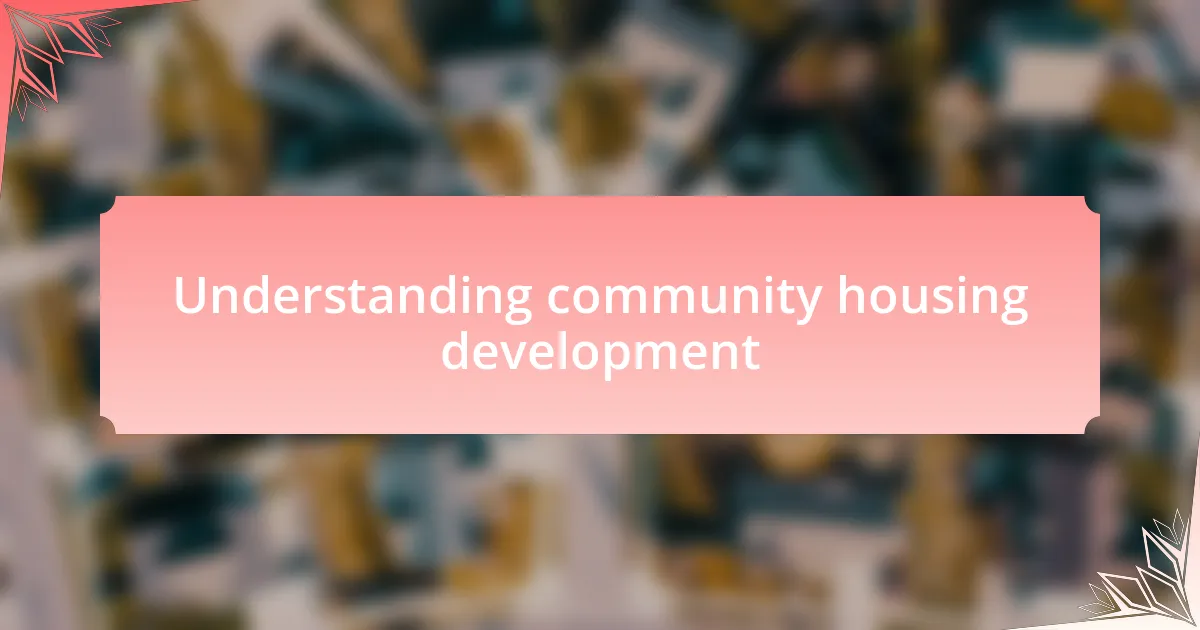
Understanding community housing development
Community housing development is fundamentally about creating spaces where people feel a sense of belonging. I remember stepping into a new community housing project and being immediately struck by the vibrant mural that adorned the entrance. It was a visual welcome, serving as a reminder that housing is not merely about shelter, but about cultivating connections.
When I think about the diverse needs of residents, it’s clear that successful community housing goes beyond bricks and mortar. Have you ever felt like an outsider in a new neighborhood? I have, and that sense of isolation can be overwhelming. That’s why it’s vital for developers to incorporate communal areas, where residents can gather and share experiences, fostering that all-important sense of community.
Engaging new residents involves understanding their unique stories and backgrounds. I once attended a welcome dinner for new tenants, where each person shared a bit about their journey. It became evident that every individual brought a distinct perspective to the community, enriching the tapestry of life within those housing developments. How do we ensure that these diverse voices are heard and valued? Dialogue is essential, and it invites a collaborative spirit that can truly transform a place into a home.

Importance of resident engagement
Engaging new residents is crucial for fostering a thriving community, and I’ve seen firsthand how it transforms perceptions. At a recent community BBQ, residents of all ages mingled and shared laughter, breaking down barriers and forging friendships. When everyone feels that they belong, the community becomes a support network where individuals lift each other up. Have you ever noticed how a simple conversation can spark a lasting connection? It’s the little moments that can lead to a stronger sense of unity.
One aspect that stands out to me is the emotional investment residents show when they are actively engaged. I remember a neighbor who felt isolated until she joined the community gardening team. Not only did she cultivate vegetables, but she also cultivated relationships, sharing her passion while helping others grow theirs. When residents are involved, they start to take pride in their surroundings, leading to better care of communal spaces. Isn’t it fascinating how participation can change the dynamics of a neighborhood?
Moreover, resident engagement empowers individuals by giving them a voice in the decision-making process. I once participated in a community forum where residents expressed their ideas for new programs. It was empowering to watch their enthusiasm as they collaborated on plans for family events and educational workshops. This collective input not only strengthens the community but also ensures that the needs and aspirations of every resident are acknowledged. How can we underestimate the power of participation when it enables others to shape their own environment?
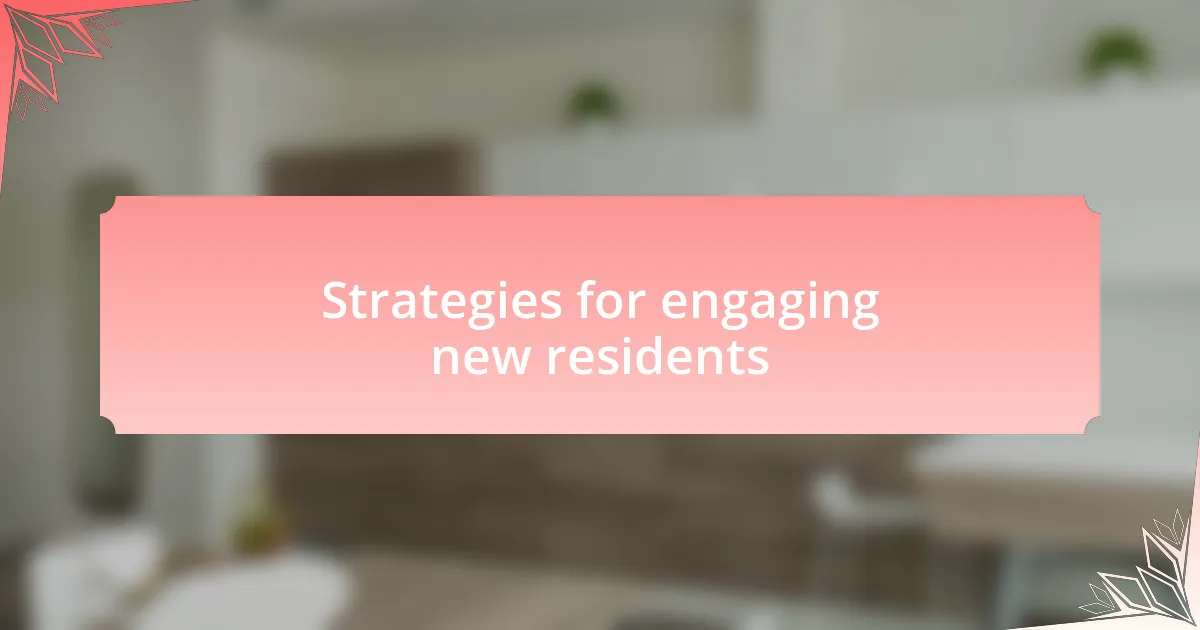
Strategies for engaging new residents
One effective strategy for engaging new residents is hosting orientation events. I recall attending a Saturday morning welcome breakfast in my neighborhood, where newcomers could meet long-term residents in a relaxed setting. This face-to-face interaction helped to break the ice and made it easier for newcomers to feel like part of the community from day one. Have you ever seen how shared meals can create bonds? They foster a sense of belonging that can set the tone for future connections.
Another strategy that has proven successful is forming interest-based groups or clubs. In my community, we started a book club that attracted a mix of ages and backgrounds. It was amazing to see how a shared passion for literature allowed for deep discussions and friendships to blossom. Isn’t it incredible how finding common ground can bridge gaps? When residents have opportunities to engage around topics they care about, it naturally leads to a stronger community.
I also believe in the power of resident-led initiatives. I remember when a group proposed a monthly clean-up day in our local park. The enthusiasm was contagious, and soon, many residents joined in, creating a sense of pride in our shared space. What struck me was how this simple act of coming together not only beautified our environment but also established a camaraderie that brought us closer. Could it be that taking action together is one of the best ways to strengthen community ties?
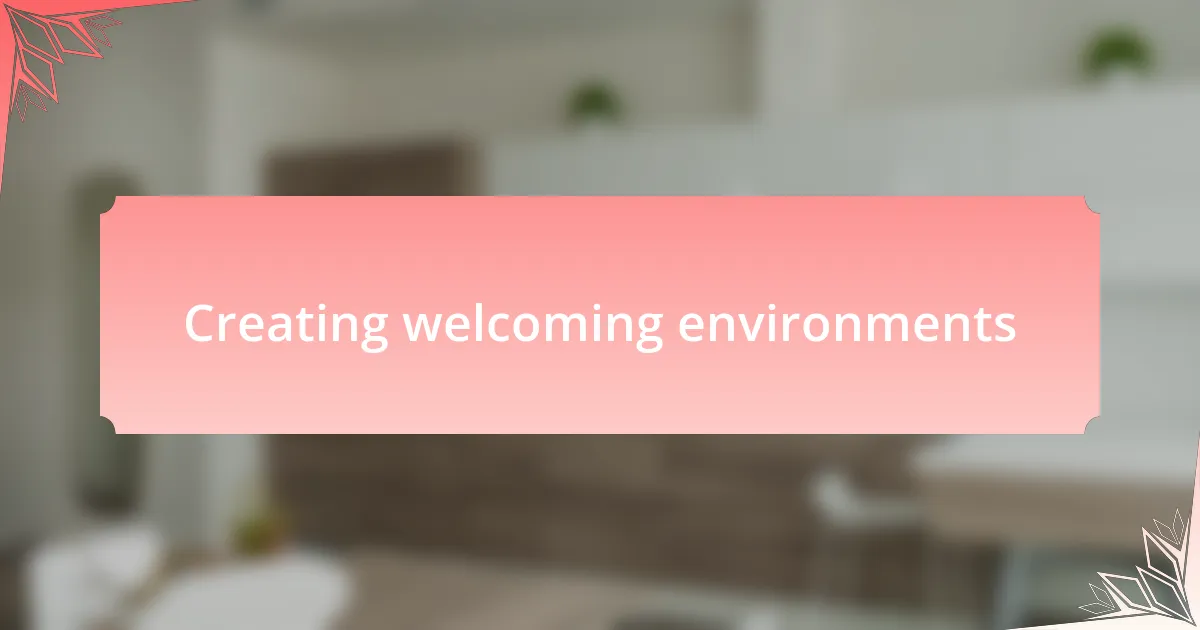
Creating welcoming environments
Creating welcoming environments is about more than just physical spaces; it’s about cultivating a feeling of safety and acceptance. I vividly remember when our neighborhood formed a “welcome wagon” team. We surprised newcomers with gift baskets filled with local treats and a little note from the community. The smiles on their faces were priceless! Can you imagine the impact of such a thoughtful gesture? It instantly made new residents feel valued and wanted.
Another key aspect lies in the beauty of open, inviting public spaces. In my experience, a well-maintained park can transform how people engage with each other. I witnessed this firsthand when my community installed a community garden. It became a gathering place where residents of all ages bonded over planting vegetables and flowers. Seeing families share gardening tips and children laughing while they played colored my perspective on togetherness. How often do you find joy in a shared space that invites conversation?
Finally, clear communication is crucial in fostering that welcoming atmosphere. I remember when our community began using a monthly newsletter to keep everyone informed about events and initiatives. This simple step not only kept residents connected but also encouraged them to participate actively. Have you noticed how staying in the loop can spark enthusiasm? It’s essential to make sure everyone feels included and engaged, as this lays the foundation for a supportive community.
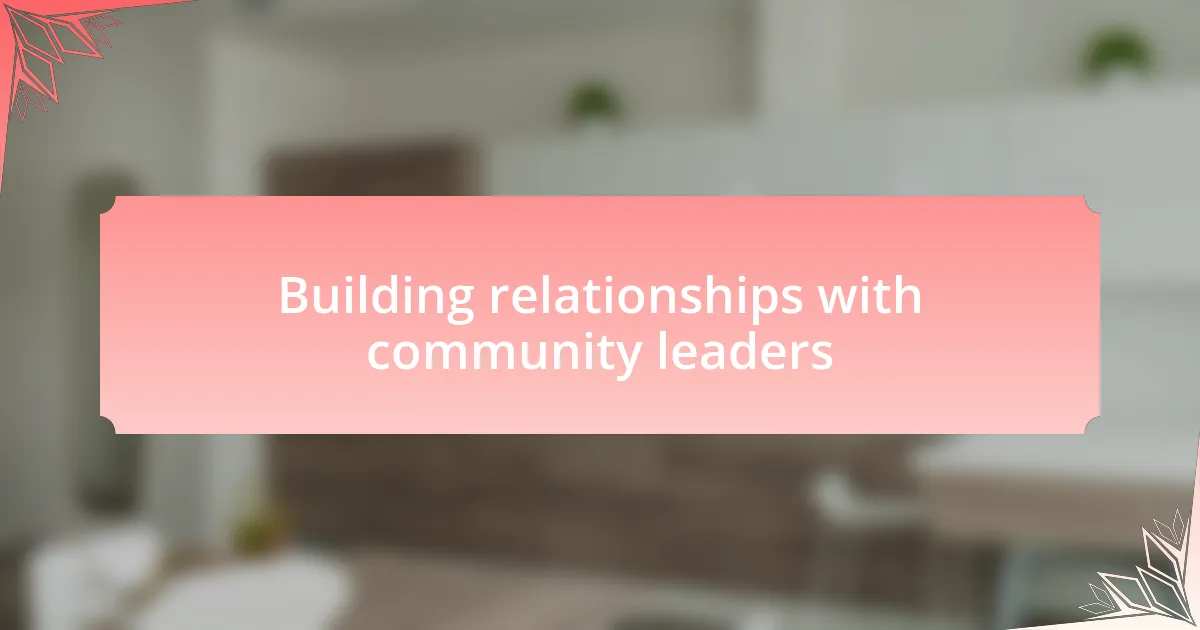
Building relationships with community leaders
Building relationships with community leaders is essential for the vitality of any neighborhood. I recall attending a local council meeting where I was surprised by the openness of our community leaders. They listened attentively to residents’ concerns and ideas, fostering an environment where collaboration could thrive. How often do we take the time to connect with those who have the power to influence change in our community?
Engaging with leaders can also create pathways for support and resources. I remember when we needed funding for a neighborhood project, and it was a local leader who stepped in to advocate for us. Their endorsement not only opened doors but also strengthened our trust in the community’s governance. Have you ever considered how a simple conversation with a local official can lead to significant improvements in your area?
Moreover, building these relationships fosters a sense of belonging and commitment. I often find myself reflecting on a community event where leaders shared their personal stories about why they serve. It was incredible to hear their passion and dedication, reminding us that they are more than just titles; they are part of our community fabric. Do you think that understanding the human side of our leaders can deepen our engagement with them?
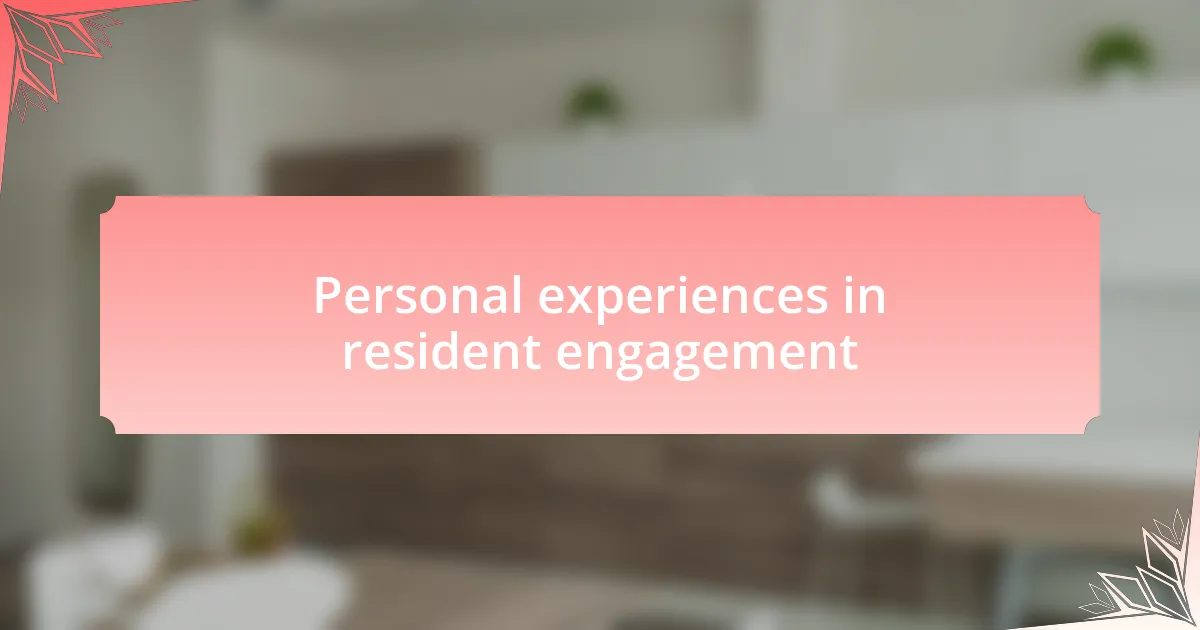
Personal experiences in resident engagement
Engaging with new residents can be a rewarding journey. I remember the first time I organized a welcome event for newcomers in our neighborhood. It was heartwarming to see families connecting over shared interests, turning strangers into friends within just a few hours. Have you ever witnessed how a simple gathering can lay the groundwork for lasting connections?
I often think about a resident who moved in just after a major storm. Their initial fear quickly turned into gratitude as neighbors rallied to lend a hand. We created a small support network that not only eased their transition but also forged a deeper bond among all of us. Isn’t it remarkable how shared experiences, especially challenging ones, can unite a community?
Reflecting on my interactions, I realize active listening plays a critical role. During one informal coffee meet-up, I truly heard a new resident’s struggles with loneliness. By offering our community’s resources and encouraging others to check in, I witnessed a positive shift. How often do we pause to really listen to the stories of those around us? Trust me; it can transform lives and enhance our community’s spirit.
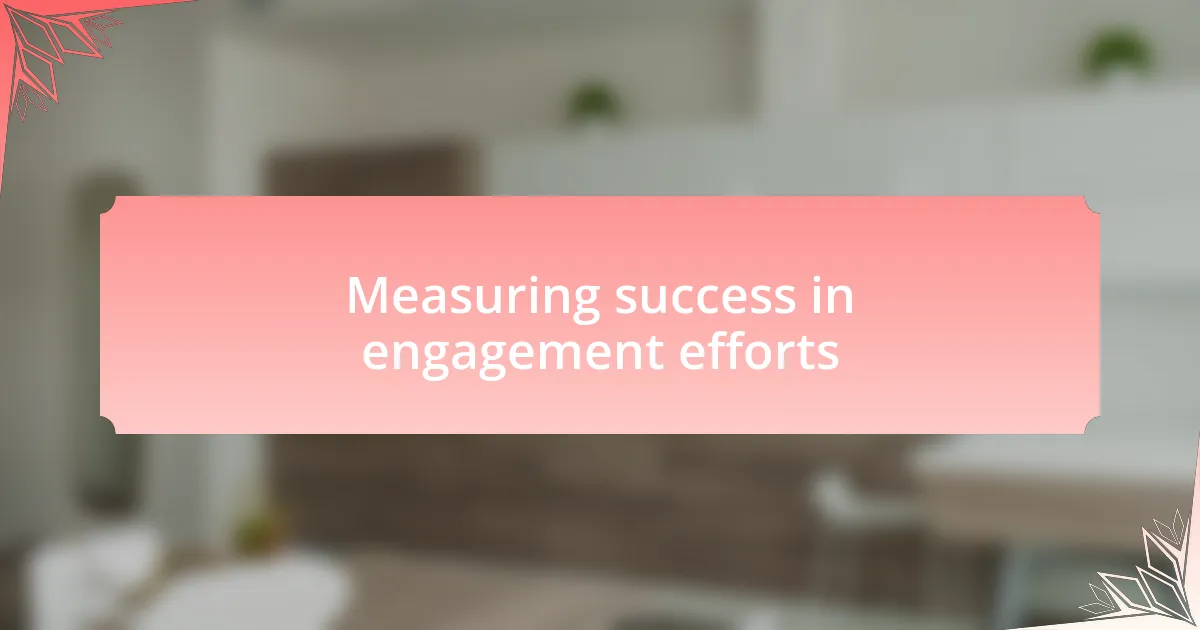
Measuring success in engagement efforts
Measuring success in engagement efforts can often be more subjective than one might think. I recall a community survey we conducted after our neighborhood picnic; the feedback revealed that 85% of attendees felt more connected to their neighbors. That figure isn’t just a statistic; it illustrates tangible emotional growth and a sense of belonging that we cultivated.
Another way to gauge our efforts is through participation rates in events. I once observed that when we introduced themed gatherings, attendance doubled compared to our previous, more conventional events. Isn’t it fascinating how creativity can spark interest and foster community involvement? This shift in engagement levels provided valuable insight into what resonates with our residents.
Equally important is the anecdotal evidence of relationships blossoming. After a volunteer day, one resident told me they had finally met their neighbor after years of living next door. Moments like these remind me that success should also be measured by the depth of connections we create. How do we truly quantify the joy of friendships formed in our community? Sometimes, it’s those heartfelt stories that matter most.